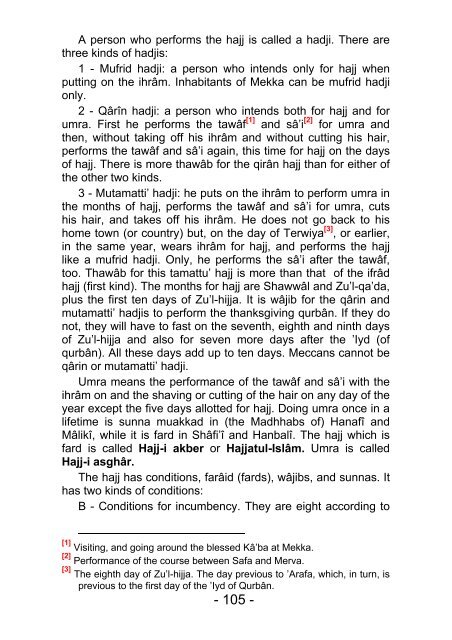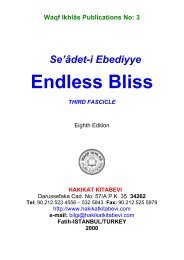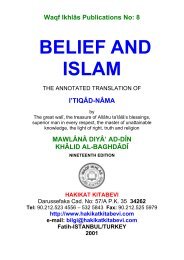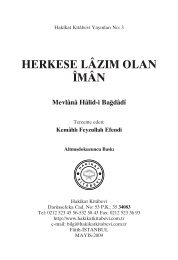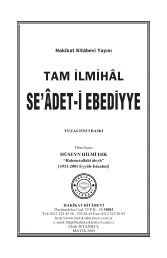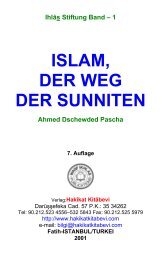5-Endless Bliss Fifth Fascicle - Hakikat Kitabevi
5-Endless Bliss Fifth Fascicle - Hakikat Kitabevi
5-Endless Bliss Fifth Fascicle - Hakikat Kitabevi
Create successful ePaper yourself
Turn your PDF publications into a flip-book with our unique Google optimized e-Paper software.
A person who performs the hajj is called a hadji. There are<br />
three kinds of hadjis:<br />
1 - Mufrid hadji: a person who intends only for hajj when<br />
putting on the ihrâm. Inhabitants of Mekka can be mufrid hadji<br />
only.<br />
2 - Qârîn hadji: a person who intends both for hajj and for<br />
umra. First he performs the tawâf [1] and sâ’i [2] for umra and<br />
then, without taking off his ihrâm and without cutting his hair,<br />
performs the tawâf and sâ’i again, this time for hajj on the days<br />
of hajj. There is more thawâb for the qirân hajj than for either of<br />
the other two kinds.<br />
3 - Mutamatti’ hadji: he puts on the ihrâm to perform umra in<br />
the months of hajj, performs the tawâf and sâ’i for umra, cuts<br />
his hair, and takes off his ihrâm. He does not go back to his<br />
home town (or country) but, on the day of Terwiya [3] , or earlier,<br />
in the same year, wears ihrâm for hajj, and performs the hajj<br />
like a mufrid hadji. Only, he performs the sâ’i after the tawâf,<br />
too. Thawâb for this tamattu’ hajj is more than that of the ifrâd<br />
hajj (first kind). The months for hajj are Shawwâl and Zu’l-qa’da,<br />
plus the first ten days of Zu’l-hijja. It is wâjib for the qârin and<br />
mutamatti’ hadjis to perform the thanksgiving qurbân. If they do<br />
not, they will have to fast on the seventh, eighth and ninth days<br />
of Zu’l-hijja and also for seven more days after the ’Iyd (of<br />
qurbân). All these days add up to ten days. Meccans cannot be<br />
qârin or mutamatti’ hadji.<br />
Umra means the performance of the tawâf and sâ’i with the<br />
ihrâm on and the shaving or cutting of the hair on any day of the<br />
year except the five days allotted for hajj. Doing umra once in a<br />
lifetime is sunna muakkad in (the Madhhabs of) Hanafî and<br />
Mâlikî, while it is fard in Shâfi’î and Hanbalî. The hajj which is<br />
fard is called Hajj-i akber or Hajjatul-Islâm. Umra is called<br />
Hajj-i asghâr.<br />
The hajj has conditions, farâid (fards), wâjibs, and sunnas. It<br />
has two kinds of conditions:<br />
B - Conditions for incumbency. They are eight according to<br />
[1] Visiting, and going around the blessed Kâ’ba at Mekka.<br />
[2] Performance of the course between Safa and Merva.<br />
[3] The eighth day of Zu’l-hijja. The day previous to ’Arafa, which, in turn, is<br />
previous to the first day of the ’Iyd of Qurbân.<br />
- 105 -


